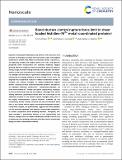| dc.contributor.author | Khare, Eesha | |
| dc.contributor.author | Grewal, Darshdeep S | |
| dc.contributor.author | Buehler, Markus J | |
| dc.date.accessioned | 2023-07-13T18:46:32Z | |
| dc.date.available | 2023-07-13T18:46:32Z | |
| dc.date.issued | 2023-05-18 | |
| dc.identifier.uri | https://hdl.handle.net/1721.1/151119 | |
| dc.description.abstract | <jats:p>Metal-coordination bonds can rupture cooperatively when loaded in shear. However, the rupture force reaches a maximum, due to a critical number of bonds that rupture cooperatively.</jats:p> | en_US |
| dc.language.iso | en | |
| dc.publisher | Royal Society of Chemistry (RSC) | en_US |
| dc.relation.isversionof | 10.1039/d3nr01287e | en_US |
| dc.rights | Creative Commons Attribution-Noncommercial | en_US |
| dc.rights.uri | http://creativecommons.org/licenses/by-nc/4.0/ | en_US |
| dc.source | RSC | en_US |
| dc.title | Bond clusters control rupture force limit in shear loaded histidine-Ni<sup>2+</sup> metal-coordinated proteins | en_US |
| dc.type | Article | en_US |
| dc.identifier.citation | Khare, Eesha, Grewal, Darshdeep S and Buehler, Markus J. 2023. "Bond clusters control rupture force limit in shear loaded histidine-Ni<sup>2+</sup> metal-coordinated proteins." Nanoscale, 15 (19). | |
| dc.contributor.department | Massachusetts Institute of Technology. Department of Materials Science and Engineering | |
| dc.contributor.department | Massachusetts Institute of Technology. Laboratory for Atomistic and Molecular Mechanics | |
| dc.relation.journal | Nanoscale | en_US |
| dc.eprint.version | Final published version | en_US |
| dc.type.uri | http://purl.org/eprint/type/JournalArticle | en_US |
| eprint.status | http://purl.org/eprint/status/PeerReviewed | en_US |
| dc.date.updated | 2023-07-13T18:42:50Z | |
| dspace.orderedauthors | Khare, E; Grewal, DS; Buehler, MJ | en_US |
| dspace.date.submission | 2023-07-13T18:42:52Z | |
| mit.journal.volume | 15 | en_US |
| mit.journal.issue | 19 | en_US |
| mit.license | PUBLISHER_CC | |
| mit.metadata.status | Authority Work and Publication Information Needed | en_US |
